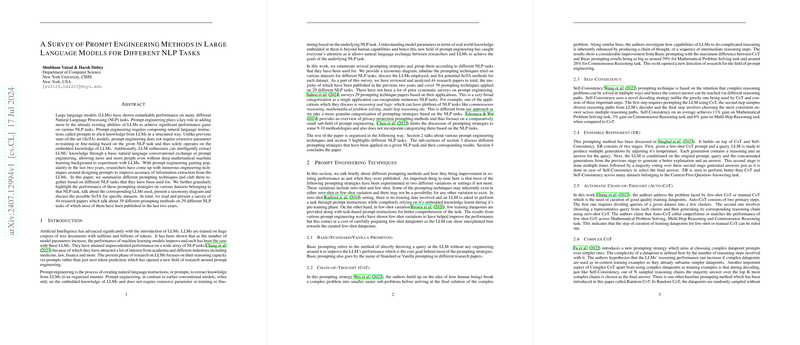A Survey of Prompt Engineering Methods in LLMs for Different NLP Tasks
Introduction
This paper offers a comprehensive survey of prompt engineering methods employed in LLMs for diverse NLP tasks. The authors, Shubham Vatsal and Harsh Dubey from New York University, provide a systematic review of 44 research papers, summarizing 39 different prompting techniques applied across 29 distinct NLP tasks. The primary focus is on improving LLM performance using prompt engineering, thereby circumventing the need for extensive parameter re-training or fine-tuning.
Prompt Engineering Techniques
The paper categorizes the prompt engineering techniques into various strategies and elaborates on their effectiveness. Each technique is discussed in terms of its basic approach, variations (such as zero-shot or few-shot learning), and its relative performance improvements on different tasks.
Key Techniques
- Basic/Standard/Vanilla Prompting: This involves straightforward queries without modifications to optimize LLM performance.
- Chain-of-Thought (CoT): Introduces intermediate reasoning steps analogous to human problem-solving, with notable performance gains, such as a 39% improvement in mathematical problem-solving.
- Self-Consistency: Utilizes diverse reasoning paths to arrive at the most consistent answer, achieving significant gains across several reasoning tasks.
- Ensemble Refinement (ER): Builds on CoT and Self-Consistency, enhancing performance through iterative generation and refinement stages.
- Automatic Chain-of-Thought (Auto-CoT): Automates the generation of reasoning chains, reducing the need for curated few-shot datapoints while matching or outperforming manual CoT.
- Program-of-Thoughts (PoT): Distinguishes reasoning from computation by generating Python programs, yielding a 12% improvement over CoT for numerical tasks.
- Tree-of-Thoughts (ToT): Employs a tree structure to manage intermediate reasoning steps, yielding a significant performance boost in problem-solving tasks by incorporating search techniques like BFS and DFS.
Performance Across NLP Tasks
The paper groups prompting methods based on their application to specific NLP tasks, offering a granular analysis of their performance on various datasets. For instance:
- Mathematical Problem-Solving: Techniques like PoT, Complex CoT, and Self-Consistency exhibited notable improvements.
- Logical Reasoning: CoC and Analogical Reasoning methods were effective across multiple datasets.
- Commonsense Reasoning: Methods such as Active-Prompt and Maieutic Prompting stood out.
- Contextual Question-Answering: Implicit RAG and CoVe showed strong performance in biomedical and legal contexts.
The authors also provide a taxonomy diagram summarizing the relationships among different NLP tasks, prompting techniques, and datasets, enhancing the clarity of the survey.
Implications and Future Developments
This paper underscores the strategic importance of prompt engineering in leveraging the latent capabilities of LLMs. Notable performance gains were achieved without extensive re-training, highlighting the efficiency of prompt engineering methodologies. The survey's detailed analysis and comprehensive categorization provide a valuable reference for researchers and practitioners aiming to enhance LLM applications in various domains.
Conclusion
This survey significantly contributes to the field by systematically categorizing and evaluating prompt engineering techniques across a wide array of NLP tasks. It offers invaluable insights into the practical applications and theoretical underpinnings of each method. Moving forward, the continuous development of novel prompting strategies and their rigorous evaluation will undoubtedly further advance the state-of-the-art in LLM performance across diverse NLP applications.
